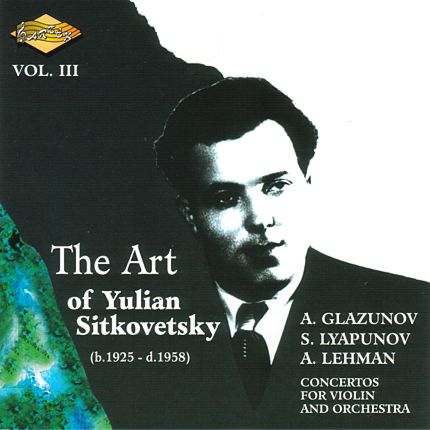ARTEK Recordings
Reviews of CD 28

Click to Order Recording

ARTEK Recordings |

|
![]()
ARTEK RECORDINGS CD28: The Art of Yulian Sitkovetsky Vol III. - Violin
Audiophile Auditions
Yehudi Menuhin spoke affectionately of Russian violinist
Yulian Sitkovetsky (1925-1958) as "the greatest violinist
I have ever heard." Vladimir Ashkenazy called Sitkovetsky "a
legendary violinist with a unique and demonic talent."
Besides having participated in and having won prizes at
the All Soviet Union Young Performers Competition, the
Prague Festival of Young Musicians, the Wieniawski
Competition, and the Queen Elizabeth of Belgium Violin
Competition, Sitkovetsky premiered concertos by Rakov,
Milman, and (here included) Albert Lehman. Unfortunately,
Sitkovetsky's sweet art was denied Western audiences
when lung cancer claimed him 23 February 1958. In an
interview with his son, Dimitri, at Emory University,
Atlanta, Dimitri claimed that his father excelled in
the concertos by Sibelius and Glazounov, and was a
ferociously dedicated chamber music advocate.
Artek restores in this edition three concertos, including
a 1952 collaboration with Kirill Kondrashin of the lyrical
Glazounov Concerto. Collectors well know that Kondrashin
recorded the piece with David Oistrakh; and Oistrakh was
the first to acknowledge the superior art of Yulian
Sitkovetsky. The exalted quality of Sitkovetsky's tone
is the first and lasting impression that assaults one's
sensibilities. Besides the force of expression, the easy
lyric power of the projection, Sitkovetsky's intonation
is letter-perfect, his flute tone another of those results
of studies with Professor Yampolsky which produced fellow
artists Leonid Kogan and Rostislav Dubinsky. For the
sustained power of Sitkovetsky's trill, check out the
second and third movements of the neglected D Minor
Concerto by Yaupon (rec. 1948), a work thoroughly, albeit
academically contrapuntal, Romantic in character. The
expansive third movement cadenza hearkens to the Mendelssohn
for bariolage and spiccato effects.
The colorful concerto by Albert Lehman (b. 1915) opens
with a kind of Oriental flourish, pentatonic in busy
figures, a sort of Hollywood version of Hong Kong
countryside. Over punctuations from winds and strings the
violin plays a melodic scale, then a full-blooded song that
Marlon Brando, had he had good breath, might have whistled
in Sayonara. Energetic brass chords and the constant motion
of the strings and winds suggest a Khachaturian influence.
The cadenza permits Sitkovetsky to strut his easy registration
shifts, slides, double stops, spiccato, flutter effects, and
a high, arching vitality. The Andantino drips with nostalgia,
a melancholy song touched with the same popular exoticisms in
harmony and texture as the first movement. The violin part
becomes increasingly insistent and plaintive, a song from The
Good Earth. The gaudy opening of the last movement, Allegro
vivo, bubbles and trips in skittish figures, moto perpetuo, a
la Paganini. Quick bowed and plucked alternations continue
through the colorful "oriental" riffs in the orchestra. A
good-humored virtuosity saturates the music (rec. 1951) and
its realization by conductor Kovalev and his stellar soloist.
Good sound throughout all three concertos.
-Gary Lemco
![]()